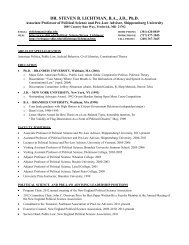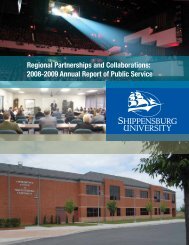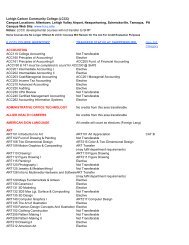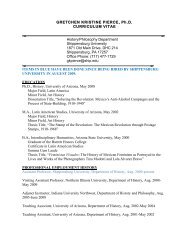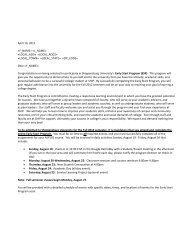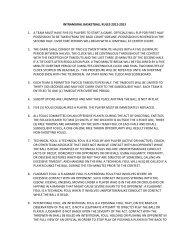57Competitive Structure of theGlobal Design, Build, andOperate (DBO) Water SupplyIndustryE d w a r d PitingoloS h i p p e n s b u r g <strong>University</strong>“Water, water everywhere, nor any drop to drink.”Samuel Taylor Coleridge, Rime of the Ancient MarinerIn the United States we take for granted the factwater is readily supplied to us by a governmentallyrelated entity or a private water company. We go tothe faucet and with a turn, water is readily dispensed.There are water fountains for drinking in many publiclocations and venues, as well as fountains for aestheticpurposes. When the bill comes for the water service,we willingly pay the requested amount for this valuablecommodity. When water service is disrupted due toa variety of events including natural disasters andpollution, we have the technology to return waterservice to normal within a reasonable amount of time.We rarely deal with permanent water supply shortages.Globally, this may not be the case. Althoughindustrialized countries enjoy a similar water scenario,other countries do not. Emerging and Third Worldcountries have water infrastructure problems, somedue to the apparent lack of development and othersto cultural components. For example, many of ourfellow citizens worldwide believe water is a free right,much like the air we breathe, and expecting monetaryremuneration for providing water service is tantamountto taxing the air we breathe. Therefore, going to a watersource and carrying water home is normal and expected– and free. However this causes multiple problems,including reinforcing poverty, as infrastructuredevelopment, that is developing undeveloped countries,hinges upon providing a stable supply of clean water.Tension exists between those expecting free waterand private companies entering a country and providingwater service, proponents of water privatization.Governments of those countries believe in the freerightconcept and do not (or cannot) fund outright thedevelopment of water infrastructure. Their citizensexpect free water. Moreover, non-governmentalorganizations (NGOs) regularly oppose and fundchallenges to establishing water infrastructure of thetype we in the United States and other industrializedcountries presuppose.The design, build, and operate (DBO) watersupply industry is examined from the viewpoint of aninternational water supplier, a French company, VeoliaEnvironnement. By examining the competitive natureof the industry, a larger picture of water supply ispresented. Additionally, since economic developmentand water supply go hand in hand, Veolia’s presence inChina is portrayed as a case of the cultural imperativesof the water business. Assessing the competitive natureof the water industry from accepted strategic modelsoccurs.Water constitutes a basic need to sustain all life.Without water, all life as we understand it will die.Civilization’s success relies on the ability to supply itscitizenry with water, dating back historically to theaqueducts of the Roman Empire. Often undertakenas the responsibility of a government to provide watersupply infrastructure, the nature of the industry evolvedwith private service providers designing, building, andoperating water distribution systems. This collaborationEdward Pitingolo is an assistant professor at <strong>Shippensburg</strong> <strong>University</strong> teaching accounting and who researches strategicmanagement of the firm utilizing management accounting techniques.
58 PROTEUS: A Journal of Ideasbetween public governmental entities and privatesubcontractors flourishes in today’s global marketenvironment.Industrialized nations typically enjoy a stable puresupply of water that easily envelops daily living at theturn of a faucet. However, emerging and Third Worldcountries have degraded water distribution, oftenimpure, with an unstable supply. Approximately onebillion people globally currently do not have adequatewater supply (Anonymous, 2004). This translates tochallenges and opportunities for firms providing design,build, and operate (DBO) services.The combination of industrialized nationssubcontracting water utility systems and developinginfrastructure in emergent and Third World countriesprovides Veolia Environnement, currently one of thelargest providers of DBO services, with ample marketshare opportunity. Cultivating appropriate strategicplans encompassing global, cultural, and politicalaspects ensures the potential for success. Examiningcomponent pieces of the competition of the watersupply industry reveals expectations for strategicallymanaging the firm. Evaluating Veolia’s position inthe industry reveals insights into the future role ofdeveloping global infrastructure in water supply thatenables economic development.Global economic development requiresinfrastructure enabling sustainable growth. The basicnature of water supply and other environmental servicesprovided by Veolia indicate the importance of itsservices. Obsolescence occurs only in the technologyemployed, not in the customer demand. This ensuresstability and growth as the population expandsglobally. Economic development in the former Sovietbloc countries, China, and Third World nations alsoguarantees the viability of the water supply, the watertreatment industry, and Veolia Environment into theforeseeable future.The Global Competitive Structure of Design, Buildand Operate Water Supply SystemsStoried history. Describing Veolia’s heritage,Chairman and CEO Henri Proglio, states: “Foundedat the dawn of the industrial era and the start of urbandevelopment, Veolia Environment has constantlyadapted to the changes in our societies over the past153 years.” This illustrates the confidence throughwhich Veolia conducts its operations. Founded in1853 through an Imperial Charter of the FrenchEmperor Napoleon III, the Compagnie Générale desEaux (CGE) mission was providing water to Frenchmetropolitan areas and irrigating French farmlands.CGE accumulated other companies in a conglomeratedportfolio of operations, including other environmentalventures dealing with waste management (VeoliaHistory 2006).After securing water supply rights to Venice in1880, CGE began global operations by expandingacross Europe. Ahead of the environmental curve, in1884 the firm began treating wastewater, in contrastwith the practice of discharging waste into nearbybodies of water. Throughout the twentieth century,CGE acquired companies in a variety of industriesspecializing in environmental processes. By 1980,CGE consolidated into a new organization known asOmnium de Traitement et de Valorisation (OTV),providing the design, build, and operate (DBO) aspectto its operations. The core companies of today’s Veoliacame together through acquisitions in the 1980s,including Connex, Onyx, and Dalkia. These holdingsbecame Vivendi Environnement in the 1990s, part ofVivendi Universal, and became a separate companythrough an initial public offering in 2000.Veolia maintains independence with no parentcompany and its stock trades on the Paris Bourse andthe New York Stock Exchange. For fiscal year 2005,its water supply systems segment represented thirtyfivepercent of total sales, increasing as a percentage oftotal revenues. Sales volume increased to over thirtyfivebillion dollars in 2005, which amounts to overtwelve billion dollars of sales for Veolia’s water systemsegment. Veolia’s operating income for the same fiscalperiod rose to almost three billion dollars and the watersystem segment constitutes half of Veolia’s operatingincome. The company operates on all populatedcontinents. Forty-eight percent of its total businessis from its home country of France and is decreasing.Operations in Europe outside of France total thirtythreepercent and is increasing. Sales in the Americasremain stable at ten percent while the nine percent ofoperations in the rest of the world is increasing (VeoliaHistory 2006).Characteristics of the industry. Although its originsrest in antiquity, centralized water distribution systemsbecame commonplace through the industrial revolutionand its concomitant urbanization (Chao & Chuang-lin2007). Municipalities and regional governments oftenprovide water systems through quasi-governmentalentities. These authorities may own and operate theirfacilities, charging consumers for water consumptionthrough a mechanized measurement meter.Outsourcing water supply capacity occurs where thegovernmental unit maintains ownership of the facilitiesand distribution network, but the subcontractedentity manages the operations. In a comprehensiveapproach, this concept results in the design, build,and operate (DBO) service: a municipality contractsthe management of the entire project and maintainsownership. This public-private partnership,characterized by transparency, exists where there is nodifferentiation between the water utility provider andthe municipality (Mann, C. C. 2007).Private water holdings also exist where a companybuys the water rights, then builds, and owns the water



